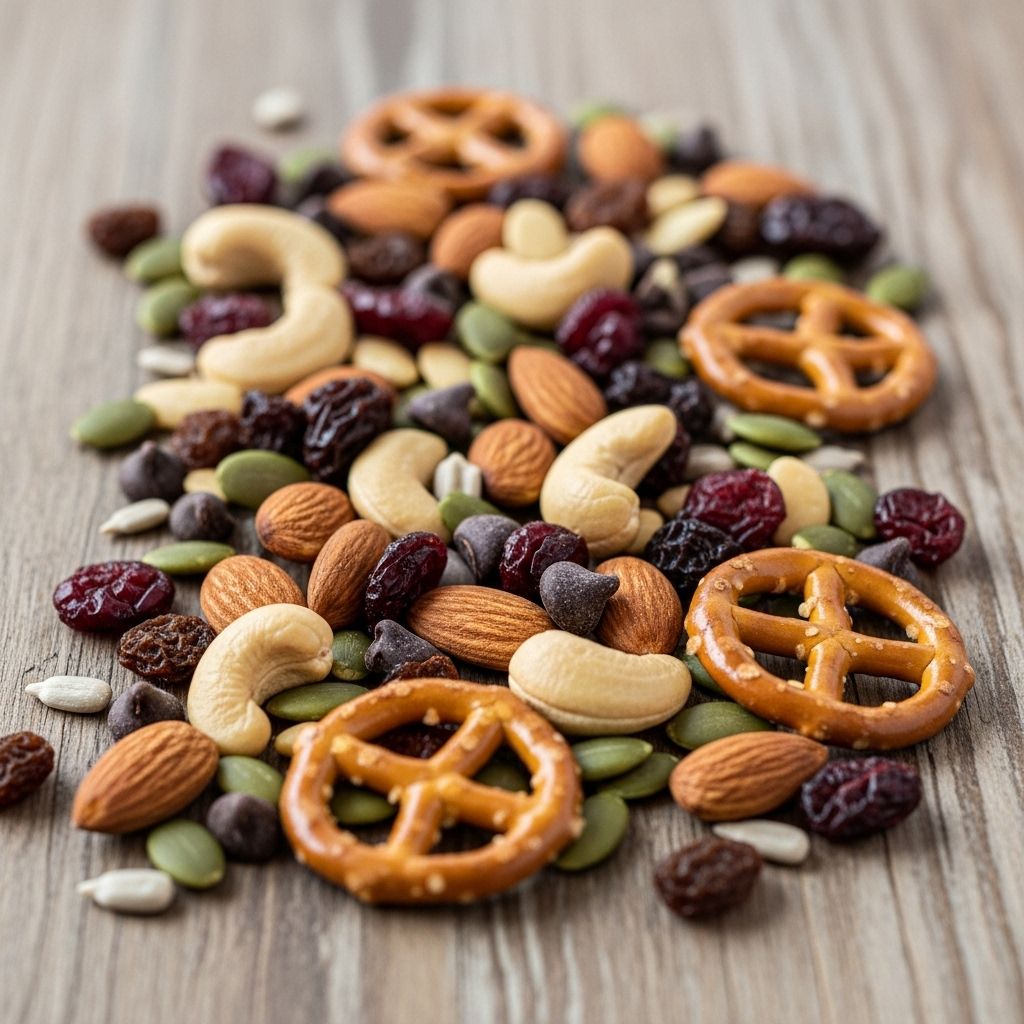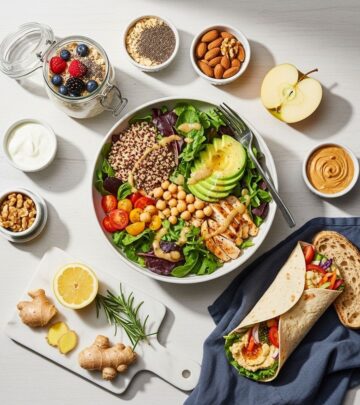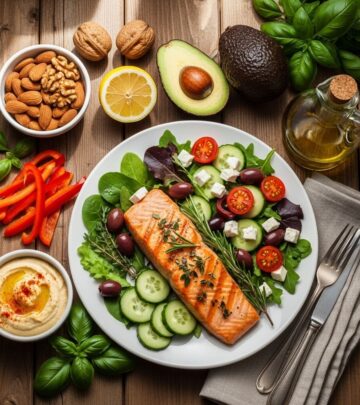Is Trail Mix Actually Good for You? Nutrition, Benefits, and Downsides
Discover the real health benefits and possible downsides of trail mix, plus expert tips for making the healthiest snack choices.

Is Trail Mix Actually Good for You?
Trail mix is a classic snack that combines nuts, seeds, dried fruits, and sometimes chocolate or other treats. Its portability and versatility make it a staple for hikers, travelers, and anyone seeking a quick energy boost. But is trail mix actually healthy? The answer depends largely on the ingredients and portion sizes. This article explores the nutritional profile of trail mix, potential health benefits, possible pitfalls, customization options, and expert tips for making the best choices.
What Is Trail Mix?
Trail mix, sometimes called GORP (good old raisins and peanuts) or student food, is a blend of nuts, dried fruits, seeds, and occasionally sweet or savory extras. Its origins trace back to nutritious, shelf-stable foods carried by travelers and explorers throughout history. Today, trail mix is popular in many cultures and can be found in countless varieties, from simple nut and raisin mixes to elaborate blends with chocolate, candies, or even cheese and crackers.
Nutritional Benefits of Trail Mix
Protein and Healthy Fats
Nuts and seeds—the backbone of most trail mixes—are excellent sources of plant-based protein and heart-healthy unsaturated fats. These nutrients are essential for muscle repair, immune function, and sustained energy. Monounsaturated and polyunsaturated fats found in nuts and seeds can help lower LDL (“bad”) cholesterol and support heart health. Omega-3 fatty acids, particularly present in walnuts, flaxseeds, and chia seeds, contribute to reduced inflammation and improved cardiovascular outcomes.
Fiber and Digestive Health
Trail mix is also a good source of dietary fiber, primarily from nuts, seeds, and dried fruits. Fiber supports digestive health, helps regulate blood sugar, and can aid in weight management by promoting feelings of fullness. Soluble fiber, found in fruits and some nuts, can help lower cholesterol and stabilize blood glucose levels.
Micronutrients
The various ingredients in trail mix supply essential vitamins and minerals. Nuts provide vitamin E (an antioxidant), magnesium (important for muscle and nerve function), and copper (vital for immune health). Dried fruits supply potassium, iron, and certain B vitamins. The combination of these nutrients supports overall well-being and may reduce the risk of chronic diseases such as heart disease and diabetes.
Energy and Portability
Trail mix is calorie-dense and provides a mix of macronutrients—carbohydrates from fruits, protein and fat from nuts and seeds—that deliver both immediate and sustained energy. This makes it an ideal snack for physical activity, travel, or times when a full meal isn’t practical.
| Ingredient | Key Nutrients | Health Benefits |
|---|---|---|
| Nuts (almonds, walnuts, cashews) | Protein, healthy fats, fiber, vitamin E, magnesium | Heart health, satiety, muscle maintenance |
| Seeds (sunflower, pumpkin, chia) | Protein, healthy fats, fiber, minerals | Heart health, digestive support, energy |
| Dried fruits (raisins, apricots, cranberries) | Fiber, natural sugars, potassium, antioxidants | Quick energy, digestive health, micronutrient boost |
| Dark chocolate | Antioxidants, flavonoids | Heart health, mood support |
Potential Downsides of Trail Mix
Calories and Portion Control
While trail mix is packed with nutrients, it’s also energy-dense, meaning small portions can contain a lot of calories. This is great for fueling physical activity, but less optimal for casual snacking without regard to quantity. Overconsumption can contribute to unwanted weight gain if not balanced with activity and caloric needs.
Sugar and Salt Content
Many commercial trail mixes contain added sugars (from candies, yogurt-coated items, or sweetened fruits) and excess salt, which can detract from their healthfulness. High sugar intake is linked to increased risk of obesity, diabetes, and tooth decay, while excess sodium can contribute to high blood pressure. Reading labels and choosing mixes with minimal added sugars and salt is advisable.
Allergies and Dietary Restrictions
Trail mix commonly contains nuts, a common allergen. Those with allergies need to avoid nut-heavy mixes and seek seed-based alternatives. Additionally, some commercial mixes may include dairy, gluten, or other allergens, so checking ingredient lists is important.
Choosing the Healthiest Trail Mix
Look for Whole, Natural Ingredients
The healthiest trail mixes are made from whole nuts, seeds, and unsweetened dried fruits. Avoid those with added sugars, hydrogenated oils, or artificial ingredients. Dark chocolate (at least 70% cocoa) is a better sweet add-in than milk chocolate or candy-coated pieces.
Balance Macronutrients
Aim for a mix of protein, healthy fats, and fiber-rich carbohydrates. A good rule of thumb is to combine several types of nuts and seeds, a moderate amount of dried fruit (preferably without added sugar), and a touch of dark chocolate or cacao nibs if desired.
Consider Homemade Options
Making trail mix at home gives you complete control over ingredients and portion sizes. Customize to your taste and dietary needs, and use airtight containers to keep it fresh.
| Component | Ideal Choices | To Limit or Avoid |
|---|---|---|
| Nuts & Seeds | Almonds, walnuts, cashews, pumpkin seeds, sunflower seeds | Fried or heavily salted nuts, those with added oils |
| Dried Fruits | Raisins, apricots, figs, unsweetened cranberries | Candied fruits, those with added sugar/syrup |
| Sweet Add-Ins | Dark chocolate (70%+ cocoa), cacao nibs | Milk chocolate, candy-coated pieces, marshmallows |
| Extras | Shredded coconut, spices (cinnamon, turmeric) | Added sugars, artificial flavors, excess salt |
How to Customize Your Trail Mix
One of the biggest advantages of trail mix is its versatility. Here are some ideas for creating your own blend:
- Classic Mix: Almonds, cashews, peanuts, raisins, and a few dark chocolate chips.
- Energy Boost: Walnuts, pumpkin seeds, dried apricots, and coconut flakes.
- Savory Twist: Roasted chickpeas, sunflower seeds, dried edamame, and a sprinkle of sea salt.
- Sweet & Tart: Pistachios, dried cherries, dark chocolate, and a dash of cinnamon.
You can also tailor trail mix to dietary preferences such as vegan, paleo, low-sugar, or gluten-free by carefully selecting ingredients.
Portion Control and Mindful Snacking
Because trail mix is calorie-dense, portion size matters. Instead of snacking from a large bag, measure out servings (typically 1/4 to 1/3 cup) to avoid overeating. Savor each handful, chewing slowly to enhance satisfaction and help manage intake.
Trail Mix for Physical Activity
Trail mix is particularly well-suited to fueling hikes, runs, or other endurance activities. Its combination of quick- and slow-release energy sources supports both immediate performance and sustained stamina. For longer outings, consider adding a salty component to help replace electrolytes lost through sweat.
Frequently Asked Questions (FAQs)
Q: Is trail mix a good snack for weight loss?
A: Trail mix can be part of a weight loss diet if consumed in controlled portions. Its protein, fat, and fiber content promote fullness, which may help with appetite control. However, its high calorie density means overeating can easily offset any benefits. Portion size and ingredient quality are key.
Q: What are the best nuts and seeds to include in trail mix?
A: Almonds, walnuts, cashews, peanuts, sunflower seeds, pumpkin seeds, and chia seeds are all excellent choices, each offering unique nutrients and health benefits. Variety ensures a broader spectrum of vitamins, minerals, and healthy fats.
Q: Can trail mix be unhealthy?
A: Yes, trail mix can be unhealthy if it contains large amounts of added sugar, salt, or unhealthy oils. Commercial mixes with candies, chocolate-covered items, or heavily processed ingredients are less nutritious than those made with whole, natural foods. Always check the ingredient list.
Q: Is homemade trail mix better than store-bought?
A: Homemade trail mix generally allows for better control over ingredients and nutrition. You can avoid added sugars, excessive salt, and unhealthy additives, and customize the mix to your dietary needs and taste preferences.
Q: How should trail mix be stored?
A: Store trail mix in an airtight container in a cool, dry place to keep it fresh. Nuts and seeds can go rancid over time due to their fat content, so refrigeration or freezing may extend shelf life for homemade blends.
Q: Can people with nut allergies eat trail mix?
A: People with nut allergies should avoid traditional trail mixes with nuts. Instead, opt for seed-only mixes (sunflower, pumpkin, chia, hemp) and check for cross-contamination warnings on packaged products.
Expert Tips for Healthier Trail Mix Snacking
- Read Labels: Choose mixes with whole, natural ingredients and minimal additives.
- Go for Unsalted: Prefer unsalted or lightly salted nuts to minimize sodium intake.
- Limit Sweet Add-Ins: Enjoy dark chocolate or naturally sweet fruits in moderation.
- Watch Portions: Measure out servings to avoid mindless overeating.
- Make It Yourself: Homemade trail mix is often the healthiest and most customizable option.
Conclusion
Trail mix can be a nutritious and convenient snack when made with wholesome ingredients and enjoyed in appropriate portions. Its combination of protein, healthy fats, fiber, and essential micronutrients supports heart health, digestion, energy levels, and overall well-being. However, the healthfulness of trail mix depends on the quality of its components and how it fits into your overall diet. By choosing carefully and customizing to your needs, you can turn trail mix into a smart, satisfying snack for active lifestyles.
Read full bio of Sneha Tete












